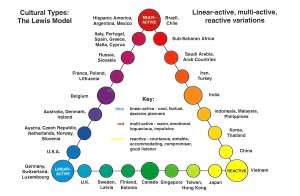The one-sentence summary
Careful analysis and understanding of distinctive cultural traits can lead to more effective leadership and collaboration across diverse nationalities.
WHAT THE BOOK SAYS 
· Originally published in 1996, this seminal work has been thoroughly updated to cover the business habits and etiquette of over 60 countries.
· Its main purpose is to offer leaders and managers practical strategies to embrace differences and work successfully across diverse business cultures.
· The author has created a model of cultural types based on three main styles:
1. Linear-Active: introvert, patient, quiet, minds own business, likes privacy, plans methodically, does one thing at a time, punctual (Germany, Switzerland, Luxembourg, emanating out to the USA and UK)
2. Multi-active: extrovert, impatient, talkative, inquisitive, gregarious, plans grand outline only, does several things at once, works any hours, not punctual (Hispanic, Argentina, Mexico, Brazil, Chile)
3. Reactive: introvert, patient, silent, respectful, good listener, looks at general principles, reacts, flexible hours, punctual, sees whole picture, reacts to partner’s timetable (Vietnam, then Japan and China)
· Understanding some of these traits can lead to a far better understanding of how to conduct meetings, negotiations, the passage of time, and many other interactions between different cultures, often inside a company.
· Views of time are particularly complex:
~ The US regard it as linear – time is money and can be divided into clear chunks.
~ Latins see time as multi-active – using human interactions to get things done, regardless of specific meetings and timetables.
~ Eastern cultures see time as cyclical – everything goes round in a circle.
~ Madagascar have an interesting one – they see the future as flowing into their heads from behind, with the past stretching out in front of them. The past is visible in this regard, whereas the future is unknown.
WHAT’S GOOD ABOUT IT
· Language is something of a straitjacket. The one you happen to speak influences the way you think. Multi-linguists are more broad-minded.
· Who is normal anyway? Attitudes depend on our perception.
· There is a set of diagrams showing leadership and organisation styles by country. They include the UK (casual), US (structured individualism), France (autocratic), Germany (hierarchy/consensus), Australia (one of the mates), Spain (human force), Japan (ringi-sho consensus).
· Anyone working in a global organisation or doing any overseas business should read this. Understanding can only increase.
WHAT YOU HAVE TO WATCH
· Not much. This is a 600-page textbook so the best approach is to read the main principles (180 pages) and then go straight to the sections that cover the cultures you most commonly interact with.

 Click to enlarge
Click to enlarge